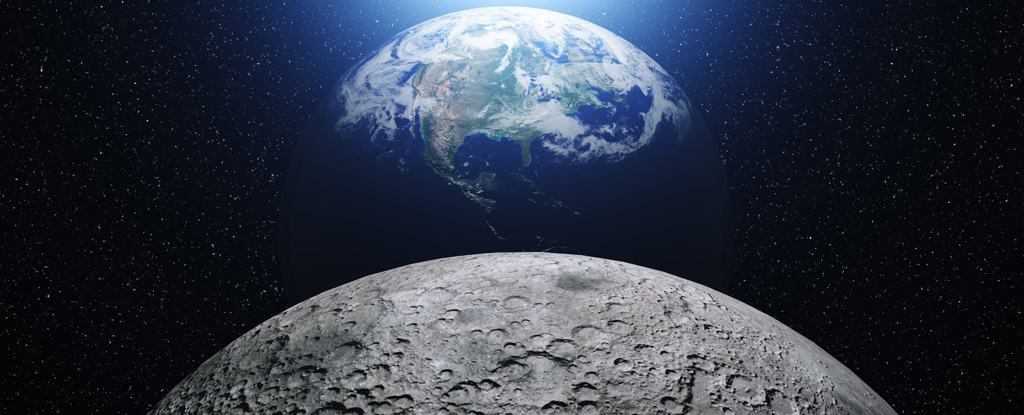The red-hot rocks that flew out of the Earth came together to become the Moon – we still don’t fully understand how this enormous drama unfolded or when it was completed.
However, a new study has shown new evidence that the “magma ocean” that spread on the moon shortly after it was formed may have solidified almost as early as 4.43 billion years ago.
This discovery is helping to paint a more precise timeline of the epic impact that engulfed the Earth and its subsequent cooling process.
In fact, it is said that around the same time, the Earth’s oceans and atmosphere were beginning to stabilize, and an environment suitable for life was beginning to take shape.
In other words, the results of this study provide a major clue in considering “when did our planet become a place friendly to life?”
In addition, a special chemical component called “KREEP” played a major role in this research.
KREEP is a dreg-like substance that contains large amounts of potassium (K), rare earth elements (REE), phosphorus (P), and radioactive elements such as uranium (U) and thorium (Th), and is thought to have been concentrated in the final stages of the Moon’s life when it became almost solid.
The timing of the moon’s crystallization, which had been shrouded in mystery until now, has been significantly shed light on this issue through KREEP’s precise analysis.
So how did the rocks blown away from the Earth come together and create a new world?
The history of the birth of the Moon and the path that our Earth has traveled are now once again being linked together.
From here, let’s unravel the secret of how the moon was born based on the detailed background and experimental results.
The Truth behind the Giant Impact Theory: The Moon Formed in 1000 Years
The most common theory that explains how the moon was formed is the “giant impact hypothesis.”
It is believed that approximately 4.5 billion years ago, a Mars-sized object called Theia collided with the young Earth, causing debris to fly around the Earth and eventually come together to form the Moon.
The energy of the collision was so great that it is highly likely that most of the Moon was in a molten state – a so-called “magma ocean.”
However, recent research has pointed out that the speed at which this magma began to solidify may have been faster than previously thought.
Some research simulations suggest that theoretically, immediately after the impact, the Moon could have solidified by about 80% in a short period of about 1,000 years.
Why so early?
Major factors include the temperature difference and vacuum environment immediately after the Moon was formed.
It is believed that outer space is extremely cold, and the moon’s hot magma would have easily lost heat to the outside.
At this stage, the entire moon appears to be a spherical “ball of fire,” but this is merely an estimate based on simulations, and further verification is expected in the future.
However, the liquid magma gradually solidified over time, and the heavier minerals that solidified first sank to the bottom while the lighter minerals floated to the top, forming the Moon’s crust and mantle.
Once the solidified rock covers the surface, it acts as an insulator, making it difficult for the remaining magma to cool completely.
As a result, it took a very long time for the last 10% or so to solidify, and it is believed that the Moon matured into its present-day form through a combination of a shocking cooling on a “millennium scale” followed by a long span of “more than tens of millions of years.”
The mysterious ingredient that attracts attention here is “KREEP.”
As mentioned above, KREEP is a residual waste material that contains potassium, rare earth elements, phosphorus, and even uranium and thorium, and is thought to have been concentrated in the final stages when the magma ocean was almost solidified.
In fact, analysis of lunar rocks has suggested that the KREEP component is widely distributed on the near side of the Moon, and may also be present near the South Pole-Aitken Basin on the far side of the Moon.
It is hoped that if we can accurately measure the timing of KREEP’s formation, we may be able to clearly determine the time of consolidation, which can be thought of as the “final touch” to the moon.
The solidification switch of the moon 4.43 billion years ago
The research team focused on the mechanism by which lutetium (Lu), which is abundant in KREEP, radioactively decays over time and turns into hafnium (Hf).
Lutetium is a rare earth element (REE), and because it does not easily enter other minerals when magma solidifies, it tends to be concentrated in the residue (KREEP).
Lutetium and hafnium are thought to have existed in equal proportions when the solar system was first formed, but over time lutetium undergoes radioactive decay, and the degree of decay can indicate the age of rocks when they crystallized.
The researchers performed an extremely precise analysis of a mineral called zircon contained in lunar rocks brought back by the Apollo missions.
Zircon is a tough mineral that is often used for radiometric dating on Earth, and once crystallized, it traps traces of time within it.
By using cutting-edge techniques to closely examine the ratio of lutetium and hafnium contained in the lunar magma, they were able to estimate when the lunar magma ocean solidified and formed KREEP.
The results showed that KREEP formed near the end of the Moon’s solidification process, and that the completion of crystallization likely occurred as far back as 4.43 billion years ago.
This corresponds to a period when the Earth was still being subjected to many celestial impacts, providing important concrete clues about how the Moon’s early evolution progressed.
Furthermore, this analysis strongly suggests that KREEP may also be distributed on the far side of the Moon (such as the South Pole-Aitken Basin), and it is hoped that this will be further supported by direct sample analysis from future exploration missions.
Moon’s Crystallization Reveals Earth’s Evolution
The period during which the Moon solidified coincides with a time when large collisions were occurring frequently on Earth.
After the big impact that formed the Moon, lava and magma activity is thought to have continued on the Earth’s surface, but eventually the oceans and atmosphere became relatively stable, and an environment suitable for the emergence of life gradually developed.
These changes on Earth and the evolution of the Moon are not unrelated, and knowing more about the formation history of the Moon will provide important clues to understanding how the Earth’s environment developed during the same period.
It has also become clear that the KREEP that the research team focused on this time is a concentrated remnant from the final stages of the formation of the lunar crust.
The uranium and thorium contained in KREEP may have acted as a radioactive heat source and influenced the moon’s later volcanic activity.
As future sample-taking missions (such as the Artemis and Chang’e missions) progress in the Antarctic-Aitken Basin and elsewhere, we will be able to learn more about whether a similar KREEP layer is present on the far side of the Moon, or whether its formation period and distribution vary from region to region.
The moon is the celestial body closest to us, but its existence is also deeply connected to the history of the Earth.
The results of this research have shed light on the dynamic relationship between the Earth and the Moon by clarifying the time when the Moon solidified.
As new evidence is added through future exploration and analysis, the grand scenario of “fragments of rock transformed into the moon” will become clearer and more accurate.
Information about the Moon will serve as an irreplaceable “time capsule” for learning when and how the Earth evolved into its present-day form.
Researchers look forward to discoveries about the as-yet-unseen far side of the moon and to further lunar samples.

